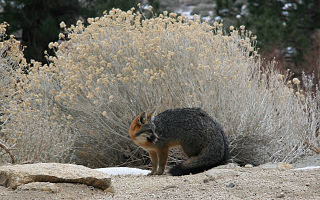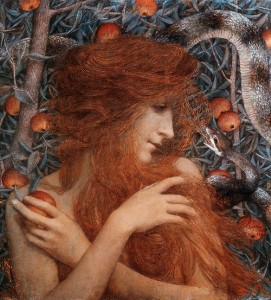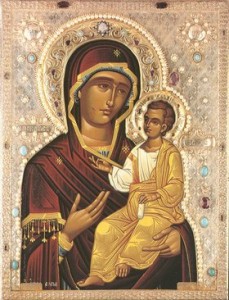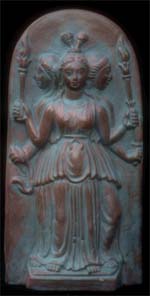 Most people who meet my casual acquaintance struggle with where to place me. Many file me with “must be Native American.” A few ask point blank if my parents were hippies. When I lived in southern Arizona, I was surprised (and a bit disturbed, because I wasn’t used to it) to discover that many Mexicans and Mexican-Americans had me pegged right away. Some (actually the majority) carefully avoided me. Others cajoled me into telling their fortunes or even asked for charms. My landlady had trouble getting repairs done because the Mexican construction workers she employed refused to enter my house. A friend of mine, also a brujo, had an even more disconcerting experience: some Spanish-speaking landscapers he hired reported him to the sheriff.In Brujas, Bultos, y Brasas: Tales of Witchcraft and the Supernatural in the Pecos Valley Nasario Garcia interviews los viejitos, the old folks, in rural New Mexico about the witches. The book reminds me of ghost story compilations from the Ozarks or Appalachia. Witches and supernatural occurrences are portrayed in wholly malevolent ways. The line between witches and healers is firmly drawn, something which contradicts my own observations in southern Arizona and in another part of New Mexico. The familiar story of folk healers defaming rival healers with accusations of witchcraft sounds like it might be part of the subtext in these reminiscences, although this is reading between the lines. Another possible parallel with other folklore of European derivation is the description of ghosts or witches as points of light – brasas or embers. In some cultures the fairies are described as sparks of light.The viejitos often talk about El Mal Ojo, the evil eye. According to Viviana Tapia, “You treated it by spitting wild pie plant with cachana, a root used to ward off evil. You had to spit it – spit in the face of the afflicted so that the evil eye could be lifted, so that it would go away. It’s cachana, that’s what the medicine is called. The same persons who would spit it are the ones who would chew it (the root). And it had to be a Juan or a Juana in order to cure the victim, got it? Any other way was not possible.”Another common theme in the interviews is La Llorona, The Wailing Woman, for those who like to collect these stories. I won’t go into this legend here today, but if there’s some interest I’ll do a post on it later.Most of the people interviewed do not appear to know anything special about witchcraft (although you never know), but there is one woman I would like to have talked to. The interviews happened about twenty years ago, so it is unlikely that any of the storytellers are still alive. I appreciated having both the Spanish and the translation. Academic researchers have a hard time understanding magical concepts, and what they interpret is highly suspect. Although my Spanish is not the best, I think the translation is dependable.I wonder if some day a folklorist in the Sonoran Desert will be collecting stories about La Bruja Gringa. I did NOT put El Ojo on anybody, just so you know. I will haunt you with a thousand brasas if you say I did.
Most people who meet my casual acquaintance struggle with where to place me. Many file me with “must be Native American.” A few ask point blank if my parents were hippies. When I lived in southern Arizona, I was surprised (and a bit disturbed, because I wasn’t used to it) to discover that many Mexicans and Mexican-Americans had me pegged right away. Some (actually the majority) carefully avoided me. Others cajoled me into telling their fortunes or even asked for charms. My landlady had trouble getting repairs done because the Mexican construction workers she employed refused to enter my house. A friend of mine, also a brujo, had an even more disconcerting experience: some Spanish-speaking landscapers he hired reported him to the sheriff.In Brujas, Bultos, y Brasas: Tales of Witchcraft and the Supernatural in the Pecos Valley Nasario Garcia interviews los viejitos, the old folks, in rural New Mexico about the witches. The book reminds me of ghost story compilations from the Ozarks or Appalachia. Witches and supernatural occurrences are portrayed in wholly malevolent ways. The line between witches and healers is firmly drawn, something which contradicts my own observations in southern Arizona and in another part of New Mexico. The familiar story of folk healers defaming rival healers with accusations of witchcraft sounds like it might be part of the subtext in these reminiscences, although this is reading between the lines. Another possible parallel with other folklore of European derivation is the description of ghosts or witches as points of light – brasas or embers. In some cultures the fairies are described as sparks of light.The viejitos often talk about El Mal Ojo, the evil eye. According to Viviana Tapia, “You treated it by spitting wild pie plant with cachana, a root used to ward off evil. You had to spit it – spit in the face of the afflicted so that the evil eye could be lifted, so that it would go away. It’s cachana, that’s what the medicine is called. The same persons who would spit it are the ones who would chew it (the root). And it had to be a Juan or a Juana in order to cure the victim, got it? Any other way was not possible.”Another common theme in the interviews is La Llorona, The Wailing Woman, for those who like to collect these stories. I won’t go into this legend here today, but if there’s some interest I’ll do a post on it later.Most of the people interviewed do not appear to know anything special about witchcraft (although you never know), but there is one woman I would like to have talked to. The interviews happened about twenty years ago, so it is unlikely that any of the storytellers are still alive. I appreciated having both the Spanish and the translation. Academic researchers have a hard time understanding magical concepts, and what they interpret is highly suspect. Although my Spanish is not the best, I think the translation is dependable.I wonder if some day a folklorist in the Sonoran Desert will be collecting stories about La Bruja Gringa. I did NOT put El Ojo on anybody, just so you know. I will haunt you with a thousand brasas if you say I did.
The Alder Tree
January 11, 2013
Another Post at Return to Mago Blog
January 10, 2013
A Look Ahead
January 4, 2013
Through Another Doorway
January 1, 2013 Janus is the Roman god of the new year, with two faces looking toward the past and the future. In his right hand he holds a key and in his left a staff. He is a god of peace whose worship was more central in matrifocal times. The month of January is named for him. Janus is a winter god, the counterpart of the summer goddess Juno. From the Pagan Book of Days:
Janus is the Roman god of the new year, with two faces looking toward the past and the future. In his right hand he holds a key and in his left a staff. He is a god of peace whose worship was more central in matrifocal times. The month of January is named for him. Janus is a winter god, the counterpart of the summer goddess Juno. From the Pagan Book of Days:
Janus is the male equivalent of one of the versions of the goddess Juno-Janus, who in her two-faced aspects of Antevorta and Postvorta looks simultaneously forward and backward as does Janus. January marks the beginning of the new year yet contains elements of that which went before. Its quality is thus one of new possibilities but constrained by that which took place in the old year before it.
SourcesJordan, Michael. Encyclopedia of Gods: Over 2,500 Deities of the World. New York: Facts on File, 1993.Pennick, Nigel. The Pagan Book of Days: A Guide to the Festivals, Traditions, and Sacred Days of the Year. Rochester, VT: Destiny Books, 1992.
Sex Changes: A memoir of marriage, gender and letting go ~ Christine Benvenuto
December 28, 2012 What happens when your world gets turned upside down and in the confusion of reevaluating all that you thought true, the people you regarded as allies distance themselves or judge you? Christine Benvenuto’s memoir of love, betrayal and change is getting attention for its portrayal of the somewhat sexy topic of sex change, but as the writer of a spiritual blog I was more drawn to the theme of community support, particularly support from religious community.Christine was in a marriage of over twenty years with three small children when her husband “Tracey” announced his intention of exploring gender transition. (Note: Christine uses male pronouns for Tracey in the book.) Over the following year, Christine resisted each step of her husband’s transition. As events unfolded, Christine says “I clung to stasis like a fraying lifeline, kicking and screaming as it slipped through my fingers.” (Christine does not like the word “transition.” She explains, “Transition implied to me something ordinary, something gentle, something – dare I say it – natural.” Although her point is well taken, I will use this word here because it is the word we have for this process.) As the transition progressed and Christine became resigned to the ending of her marriage, she insists that a new Tracey emerged: “He didn’t seem the same. He didn’t act the same, didn’t sound the same. His values seemed to change along with his personality.” The new Tracey was controlling and abusive. He expected her to adjust to marriage with a transwoman. He made promises and concessions and repeatedly reneged on them, often insisting such agreements had never been made. When Christine insisted that the marriage must end if he persisted with the transition, Tracy took a page out of so many controlling husbands’ playbook and threatened her with loss of her children and possessions.I’m always skeptical when I hear that a spouse has abruptly changed from a supportive partner to a controlling one. Particularly in a marriage as long-standing as this one, it seems more likely that those behaviors were there all along and became more pronounced. Still, Christine’s reaction to her husband’s transition was not one of a traumatized wife. When initially confronted with the changes, she argued that Tracey’s transition robbed her of a husband and that it was damaging to their children. When Tracey would not abandon transition she separated from him and fought for her rights under divorce laws. She also insisted on viewing Tracey’s transition from her own perspective rather than accepting Tracey’s narrative. And it was Christine, not Tracey, who longed to shroud the embarrassment of their disintegrating relationship in secrecy. She explains “I grew up in a family and a culture in which, if something bad happened, you didn’t advertise.” Fortunately for her, Tracey wanted their small town, religious community, and circle of friends to learn about and understand his transition, so secrecy could not remain an option. But this is the point where life for Christine, for awhile, truly became rough.Tracey’s psychotherapist, perhaps not surprisingly, chose to view the situation from Tracey’s individual perspective and in his personal self-interest rather than in a systemic way, through family dynamics. Somewhat more surprisingly, Christine encountered judgment and ostracism from her liberal small town and individuals in her religious community. This was because, in their view, she had failed to support Tracey sufficiently in his transition. Also, because Tracey was angry with her, the community felt a need to side with him because he was transgendered. Christine charges that in the point of view of the community, his being transsexual means “Anything he does is justified.”Perhaps I overidentified with this part of Christine’s narrative. The parallel between her experience and the persecution of Dianic witches in recent years is striking. Ostensibly both have been about supporting trans rights versus born-women’s autonomy. I would argue that this is a false choice, but it is a choice pagans believe they are forced to make, even if they would not frame the issue so starkly. That the interests of genetic women are abandoned in this situation is not surprising, really. The mutterings against a religious subculture defined by women have been long-standing in the larger pagan community, albeit rather muted before the issue of trans inclusion appeared as a politically correct cudgel. Applying this insight to Christine’s situation, perhaps the community was responding out of their ingrained bias that a wife should support her husband over her own interests. Tracey’s new presentation as a transwoman to people who had known him as a man, and doubtless still thought of him as a man despite their desire to appear otherwise, may have allowed the community to fool themselves into thinking that they were not acting out age-old patriarchal patterns. At any rate, it was the betrayal by community that was hardest to overcome. Christine says:
What happens when your world gets turned upside down and in the confusion of reevaluating all that you thought true, the people you regarded as allies distance themselves or judge you? Christine Benvenuto’s memoir of love, betrayal and change is getting attention for its portrayal of the somewhat sexy topic of sex change, but as the writer of a spiritual blog I was more drawn to the theme of community support, particularly support from religious community.Christine was in a marriage of over twenty years with three small children when her husband “Tracey” announced his intention of exploring gender transition. (Note: Christine uses male pronouns for Tracey in the book.) Over the following year, Christine resisted each step of her husband’s transition. As events unfolded, Christine says “I clung to stasis like a fraying lifeline, kicking and screaming as it slipped through my fingers.” (Christine does not like the word “transition.” She explains, “Transition implied to me something ordinary, something gentle, something – dare I say it – natural.” Although her point is well taken, I will use this word here because it is the word we have for this process.) As the transition progressed and Christine became resigned to the ending of her marriage, she insists that a new Tracey emerged: “He didn’t seem the same. He didn’t act the same, didn’t sound the same. His values seemed to change along with his personality.” The new Tracey was controlling and abusive. He expected her to adjust to marriage with a transwoman. He made promises and concessions and repeatedly reneged on them, often insisting such agreements had never been made. When Christine insisted that the marriage must end if he persisted with the transition, Tracy took a page out of so many controlling husbands’ playbook and threatened her with loss of her children and possessions.I’m always skeptical when I hear that a spouse has abruptly changed from a supportive partner to a controlling one. Particularly in a marriage as long-standing as this one, it seems more likely that those behaviors were there all along and became more pronounced. Still, Christine’s reaction to her husband’s transition was not one of a traumatized wife. When initially confronted with the changes, she argued that Tracey’s transition robbed her of a husband and that it was damaging to their children. When Tracey would not abandon transition she separated from him and fought for her rights under divorce laws. She also insisted on viewing Tracey’s transition from her own perspective rather than accepting Tracey’s narrative. And it was Christine, not Tracey, who longed to shroud the embarrassment of their disintegrating relationship in secrecy. She explains “I grew up in a family and a culture in which, if something bad happened, you didn’t advertise.” Fortunately for her, Tracey wanted their small town, religious community, and circle of friends to learn about and understand his transition, so secrecy could not remain an option. But this is the point where life for Christine, for awhile, truly became rough.Tracey’s psychotherapist, perhaps not surprisingly, chose to view the situation from Tracey’s individual perspective and in his personal self-interest rather than in a systemic way, through family dynamics. Somewhat more surprisingly, Christine encountered judgment and ostracism from her liberal small town and individuals in her religious community. This was because, in their view, she had failed to support Tracey sufficiently in his transition. Also, because Tracey was angry with her, the community felt a need to side with him because he was transgendered. Christine charges that in the point of view of the community, his being transsexual means “Anything he does is justified.”Perhaps I overidentified with this part of Christine’s narrative. The parallel between her experience and the persecution of Dianic witches in recent years is striking. Ostensibly both have been about supporting trans rights versus born-women’s autonomy. I would argue that this is a false choice, but it is a choice pagans believe they are forced to make, even if they would not frame the issue so starkly. That the interests of genetic women are abandoned in this situation is not surprising, really. The mutterings against a religious subculture defined by women have been long-standing in the larger pagan community, albeit rather muted before the issue of trans inclusion appeared as a politically correct cudgel. Applying this insight to Christine’s situation, perhaps the community was responding out of their ingrained bias that a wife should support her husband over her own interests. Tracey’s new presentation as a transwoman to people who had known him as a man, and doubtless still thought of him as a man despite their desire to appear otherwise, may have allowed the community to fool themselves into thinking that they were not acting out age-old patriarchal patterns. At any rate, it was the betrayal by community that was hardest to overcome. Christine says:
Because he believed he was doing what he had to do, it is easier, ironically, for me to forgive Tracey than the community who supported him and abandoned my children and me…. By these people, many of them women, many of them Jewish, many of them feminists, my children and I were betrayed. In the Valley of the Politically Correct, their choice wasn’t difficult or brave. It required them to be deeply true to nothing and no one. It was cowardice, pure and simple.
Tracey’s decision to transition was ultimately a good thing for Christine, despite Tracey’s selfishness toward her and their children, despite the harsh rewriting of what she had believed was a happy marriage, despite the loss of her religious fellowship, and despite the coolness of self-advertised progressives in her community. Her pain was too great to endure in isolation, and she was forced to risk an intimacy in her friendships that she otherwise would not have. She learned who her friends were and who they weren’t. “A religious community we thought we could rely on fell away; once peripheral friends drew close.” As dedicated religious fellowships became less central, Christine began to bring a spiritual perspective into her friendships, asking that close friends, Jewish or not, begin relating to her as a religious person. To her surprise, people who had not pulled away from her which she separated from her husband accepted her on other levels as well.Sex Changes chronicles one woman’s acceptance of unwelcome changes that eventually improved her life. It also raises troubling questions about how communities are dealing with transgender issues.
Z is for Zuill
December 21, 2012 Zuill, pronounced “Yule,” is a Scottish name, probably meaning “born at Christmas.” It’s my Winter Solstice gift to all word game enthusiasts who need another “Z.”December 25th was the date on the Roman calendar corresponding to the winter solstice when the date of Christ’s birth was first marked. Although this mistake was eventually corrected (the mistake of the winter solstice, not the mistake of Christ’s birthday), it was not as gross an error as you might imagine. For many days near the winter solstice the nights are of equal length. In addition to the date of the Christ mass, some things that Christmas borrowed from the older Pagan holiday include the name “Yule,” the decorated tree, the spirit of merrymaking, the Yule log, holly, mistletoe, candles, the “twelve days,” gift giving, wreathes, feasting, and Santa Claus. Things shared between the Pagan holiday and the biblical account of Christ’s birth include the divine child, the virgin birth, gold, and incense. There have been later innovations associated with Christmas that can be traced neither to the Bible nor pre-Christian traditions, and a few of these include Christmas cards, the little drummer boy, and Black Friday.When I first heard the term “War on Christmas” several years ago my initial thought was, “Oh no, the Christians are trying to abolish Christmas again.” The original Christ mass only got started because Christian converts refused to abandon their winter solstice festivities, and the holiday has always had its detractors. During the Protestant Reformation criticism of Christmas reached a critical mass. The Puritans, especially, were determined to stamp out what they believed was a Pagan celebration, and much of the popular backlash against the Puritans stemmed from their unrelenting attack on Christmas. The Puritans established their utopian communities in New England partly with the aim of escaping Christmas.The “War on Christmas” is generally seen as a way of galvanizing conservative furor through a thinly veiled, paranoid attack on non-Christians. Certainly this “war” does fuel Christian intolerance. But I have a different take on the motivation and strategy behind the Christian Christmas antiwar propoganda. It relates to the uneasy alliance between fundamentalist Christians and big business in the conservative political movement. On the part of big business, the uneasiness lies partly with Christian persecution of gays and rigid enforcement of stereotypic gender roles, both of which interfere with marketing efforts across demographics. Christian morality applied to popular culture has even moved the entertainment industry politically in line with liberals. But it is the anti-capitalist sentiment within very conservative Christianity that is the source of the greatest tension.There is always been an anti-capitalist element within Christianity consistent with Christianity’s anti-materialist roots. To the most devout conservative Christians, Christmas represents materialism and popular culture wrapped up in one Pagan package. There are many groups which believe the celebration of Christmas is anti-Christian, including the Jehovah’s Witnesses, the Church Of God, and a long list of Pentecostal churches. Within other churches, such as the Seventh-day Adventists, the Church of Christ, and many smaller Baptist churches, there is a sizable minority who vocally oppose the observation of Christmas. Even those conservative Christians who celebrate Christmas bemoan what they term the “commercialization” of the holiday.As fundamentalist Christianity has gained strength and traction, there has been the possibility of a stronger grassroots movement against Christmas taking hold, particularly as Pagans, who own the holiday much more than Christians, have risen in visibility if not in absolute numbers. Enter the ingenious strategy of Fox News and The American Family Association, a Christian political organization that allies in itself with big business concerns in a number of ways, such as by being pro-fossil fuel and anti-union. By framing opposition to Christmas as an attack by “liberals” (read atheists and Jews), the celebration of Christmas becomes a defense of Christianity. Christian animosity toward business (big and small) can be channeled into opposition to the word “holiday” in advertising. The message is that commercial interests at Christmas are okay as long as they specify that they are in support of beleaguered Christians.Many people look askance at the attempts to galvanize conservative Christians into defending a holiday that, if anything, is in danger of taking over the world, or at least the calendar. This is actually an attempt by right wing media, which is owned by big business, to manage the base and keep the Christian/capitalist alliance in place.SourcesBabyNames.comKealthley, J. Hampton III. Should Christians Celebrate Christmas? Bible.org.Popper, Nathaniel. Boycotts Bloom as Religious Conservatives Wage Battle Over Christmas. Jewish Daily Forward, 2005.
Zuill, pronounced “Yule,” is a Scottish name, probably meaning “born at Christmas.” It’s my Winter Solstice gift to all word game enthusiasts who need another “Z.”December 25th was the date on the Roman calendar corresponding to the winter solstice when the date of Christ’s birth was first marked. Although this mistake was eventually corrected (the mistake of the winter solstice, not the mistake of Christ’s birthday), it was not as gross an error as you might imagine. For many days near the winter solstice the nights are of equal length. In addition to the date of the Christ mass, some things that Christmas borrowed from the older Pagan holiday include the name “Yule,” the decorated tree, the spirit of merrymaking, the Yule log, holly, mistletoe, candles, the “twelve days,” gift giving, wreathes, feasting, and Santa Claus. Things shared between the Pagan holiday and the biblical account of Christ’s birth include the divine child, the virgin birth, gold, and incense. There have been later innovations associated with Christmas that can be traced neither to the Bible nor pre-Christian traditions, and a few of these include Christmas cards, the little drummer boy, and Black Friday.When I first heard the term “War on Christmas” several years ago my initial thought was, “Oh no, the Christians are trying to abolish Christmas again.” The original Christ mass only got started because Christian converts refused to abandon their winter solstice festivities, and the holiday has always had its detractors. During the Protestant Reformation criticism of Christmas reached a critical mass. The Puritans, especially, were determined to stamp out what they believed was a Pagan celebration, and much of the popular backlash against the Puritans stemmed from their unrelenting attack on Christmas. The Puritans established their utopian communities in New England partly with the aim of escaping Christmas.The “War on Christmas” is generally seen as a way of galvanizing conservative furor through a thinly veiled, paranoid attack on non-Christians. Certainly this “war” does fuel Christian intolerance. But I have a different take on the motivation and strategy behind the Christian Christmas antiwar propoganda. It relates to the uneasy alliance between fundamentalist Christians and big business in the conservative political movement. On the part of big business, the uneasiness lies partly with Christian persecution of gays and rigid enforcement of stereotypic gender roles, both of which interfere with marketing efforts across demographics. Christian morality applied to popular culture has even moved the entertainment industry politically in line with liberals. But it is the anti-capitalist sentiment within very conservative Christianity that is the source of the greatest tension.There is always been an anti-capitalist element within Christianity consistent with Christianity’s anti-materialist roots. To the most devout conservative Christians, Christmas represents materialism and popular culture wrapped up in one Pagan package. There are many groups which believe the celebration of Christmas is anti-Christian, including the Jehovah’s Witnesses, the Church Of God, and a long list of Pentecostal churches. Within other churches, such as the Seventh-day Adventists, the Church of Christ, and many smaller Baptist churches, there is a sizable minority who vocally oppose the observation of Christmas. Even those conservative Christians who celebrate Christmas bemoan what they term the “commercialization” of the holiday.As fundamentalist Christianity has gained strength and traction, there has been the possibility of a stronger grassroots movement against Christmas taking hold, particularly as Pagans, who own the holiday much more than Christians, have risen in visibility if not in absolute numbers. Enter the ingenious strategy of Fox News and The American Family Association, a Christian political organization that allies in itself with big business concerns in a number of ways, such as by being pro-fossil fuel and anti-union. By framing opposition to Christmas as an attack by “liberals” (read atheists and Jews), the celebration of Christmas becomes a defense of Christianity. Christian animosity toward business (big and small) can be channeled into opposition to the word “holiday” in advertising. The message is that commercial interests at Christmas are okay as long as they specify that they are in support of beleaguered Christians.Many people look askance at the attempts to galvanize conservative Christians into defending a holiday that, if anything, is in danger of taking over the world, or at least the calendar. This is actually an attempt by right wing media, which is owned by big business, to manage the base and keep the Christian/capitalist alliance in place.SourcesBabyNames.comKealthley, J. Hampton III. Should Christians Celebrate Christmas? Bible.org.Popper, Nathaniel. Boycotts Bloom as Religious Conservatives Wage Battle Over Christmas. Jewish Daily Forward, 2005.
On the Atrocity at Sandy Hook Elementary School
December 14, 2012The horror of today’s shooting at the elementary school in Newtown, Connecticut is too extreme to be expressed in words, so I will not try. I know that we all are profoundly affected. Children, and not only the children at the school, will be traumatized by the event. News media will be obsessed with these events for several weeks, perhaps justifiably so, and the exposure of children to the constant and macabre details that emerge will need to be monitored.As the president noted in his briefing, mass shootings by the solitary gunman are happening at an intolerable frequency, and I pray that his promise that concrete action to prevent further atrocities will be fulfilled. The forthcoming discussion will probably include a look at ways of banning assault weapons and restricting gun ownership by mentally unstable individuals, as well as drawing attention to the limited availability of competent mental health treatment. I wonder if and when we will ever look at the fact that these shootings are nearly always committed by males. Certainly not all men are violent, but the role of male socialization in creating violence will have to be addressed at some point if we are ever to live in a peaceful world.In rural America we tend to think of violence, particularly violence from strangers, particularly violence on a massive scale, as being an urban problem. We need to break through the tendency to isolate ourselves from the idea of violence occurring where we live in order to address the problem on a cohesive level.
The Y-Junction
December 14, 2012 The goddess Hecate is often referred to as “Goddess of the Three-Formed Crossroads,” a title which strengthens my belief that she was originally a goddess of the waterways. By “three-formed” the title refers to a junction of three roads meeting in a “Y.” In Greece a statue of the goddess was sometimes placed at such a crossroad, her three faces pointing in three directions. Offerings of food would be placed there, particularly by those embarking on a journey.
The goddess Hecate is often referred to as “Goddess of the Three-Formed Crossroads,” a title which strengthens my belief that she was originally a goddess of the waterways. By “three-formed” the title refers to a junction of three roads meeting in a “Y.” In Greece a statue of the goddess was sometimes placed at such a crossroad, her three faces pointing in three directions. Offerings of food would be placed there, particularly by those embarking on a journey.


